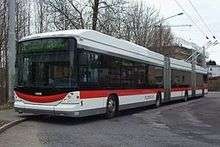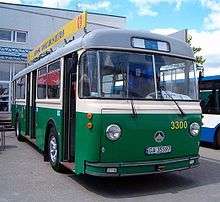Trolleybuses in St. Gallen
The St. Gallen trolleybus system (Alemannic German: Trolleybussystem St. Gallen) forms part of the public transport network of St. Gallen, the capital city of the canton of St. Gallen, Switzerland.
| St. Gallen trolleybus system | |||
|---|---|---|---|
 VBSG Hess bi-articulated trolleybus no. 189, in 2012. | |||
| Operation | |||
| Locale | St. Gallen, Switzerland | ||
| Open | 18 July 1950 | ||
| Status | Open | ||
| Routes | 4 | ||
| Operator(s) | Verkehrsbetriebe St.Gallen (VBSG) | ||
| Infrastructure | |||
| Electrification | 600 V DC | ||
| Statistics | |||
| Route length | 22.6 km (14.0 mi) | ||
| |||
| Website | Verkehrsbetriebe der Stadt St. Gallen VBS (in German) | ||
Opened in 1950, the system is currently operated by Verkehrsbetriebe St.Gallen (VBSG). As of 2012, it consists of a cross-city line and three radial lines, all of which meet at St. Gallen railway station, and has a total route length of 22.6 km (14.0 mi).[1]
History
In the 1950s, the trolleybus system gradually replaced the St. Gallen tramway network. The last tram ran on 30 September 1957. The individual trolleybus line sections went into service as follows:
| 18 July 1950 | Bahnhof–Riethüsli | Line 5 | Tramway replacement |
| 15 November 1950 | Bahnhof–Heiligkreuz | Line 3 | Tramway replacement |
| 1 October 1957 | Stocken–Erlachstrasse–Bahnhof–Neudorf | Line 1 | Tramway replacement |
| 1968 | Neudorf–Stephanshorn | Line 1 | New connection |
| 1970 | Bahnhof–Rotmonten | Line 5 | Motorbus replacement |
| 1 April 1989 | Stocken–Bahnhof Winkeln | Line 1 | Motorbus replacement |
| September 1991 | Neudorf–Guggeien | Line 1 | Motorbus replacement |
| 28 September 1996 | Erlachstrasse–Wolfganghof | Line 1 | Motorbus replacement |
| 28 May 2000 | Bahnhof Winkeln–Winkeln (500 metres) | Line 1 | New connection |
Lines
The present system is made up of the following lines:
| 1 | Winkeln–Erlachstrasse–Bahnhof–Neudorf–Stephanshorn | Business days at 12-minute intervals | Operated by seven vehicle runs (or duties) |
| 3 | Bahnhof–Heiligkreuz | Business days at 7.5-minute intervals | Operated by four vehicle runs |
| 4 | Wolfganghof–Erlachstrasse–Bahnhof–Neudorf–Guggeien | Business days at 12-minute intervals | Operated by four vehicle runs |
| 5 | Riethüsli–Bahnhof–Rotmonten | Business days at 10-minute intervals | Operated by four vehicle runs |
To this day, the Trogenerbahn (Trogen Railway) runs through the inner city between the station and Brühltor on the rails of the former tramway, and thus parallel to the trolleybuses. The two modes of transport still share a common electrical substation. In the relevant section of the common route, the overhead wire voltage is only 600 V DC, as is the rest of the trolleybus system. By contrast, the remainder of the Trogenerbahn route was energised at 1,000 V DC. It now forms part of the Appenzell–St. Gallen–Trogen railway and the section that was energised at 1,000 V DC, is now energised at 1,500 V DC.
In Riethüsli, the terminus of Line 5, there is an interchange station for changing between the trolleybus system and the electrically operated Appenzell–St. Gallen–Trogen railway. Before the opening of the Ruckhalde Tunnel and rerouting of the line in 2018, the two systems used common overhead catenary poles at that station and suspension wires for about 300 m (980 ft), but were electrically isolated from each other.
Line 4 has existed only since 9 December 2007.[2] Previously, line 1 had had three different termini from 1991, and four from 1996.
Fleet
Retired fleet
| Fleet nos. | Quantity | Built | Manufacturer | Electrics | Type | Configuration | Notes |
|---|---|---|---|---|---|---|---|
| 101–118 | 18 | 1950 | Saurer | BBC | Rigid (two-axle) | Rebodied later; see 131–148 | |
| 119–130 | 12 | 1957–58 | Saurer | BBC | 4 TP | Rigid (two-axle) | Withdrawn 1991–92 |
| 131–148 | 18 | 1968–75 | Saurer | BBC | Rigid (two-axle) | Chassis ex-101–118 (not in sequence); withdrawn 1985[3]–92 | |
| 101–111 | 11 | 1984–85 | Saurer / Hess | BBC-Sécheron | GT 560/620-25 | Articulated | Withdrawn 2008[4] |
| 151–154, 156–168 | 17 | 1991–92 | NAW / Hess | ABB | BGT 5-25 | Articulated | No. 155 converted to bi-articulated and kept in service (see below); others withdrawn 2008–09[5] |
| 151–152 (to 1957) 301–302 (from 1957) | 2 | 1953–54 | Moser / Ramseier & Jenzer | none | Trailer | Withdrawn | |
| 303–327 | 25 | 1957 | Moser / FFA | none | Trailer | Also hauled by motorbuses; withdrawn starting in 1985[3] | |
| 328–339 | 12 | 1969–70 | Hess / R&J[3] or Moser | none | Trailer | Also hauled by motorbuses; withdrawn between 1985[3] and 1992[6] | |
The original group numbered 101–118, the fleet that opened the system in 1950, were rebodied by Hess between 1968 and 1975[3][6] and fitted with a new backup battery. They were simultaneously renumbered as fleet nos. 131–148, but not in the same sequence. Trailer operations ended either in 1991[7] or in March 1992.[8]
Disposal abroad

- In 1992, all twelve[9] trolleybuses of the 1957–58 series were sold, together with the 1969–70 trailers, to the Warsaw trolleybus system in Poland, and were placed in service. That system was nevertheless closed soon afterwards, in 1995. One of the former St. Gallen/Warsaw trolleybuses (No. 128) was sold in 2001 to the Gdynia trolleybus system,[10] also in Poland, where it later came into use as a heritage vehicle, renumbered 3300, operating service occasionally.[11] By 2012, its original, St. Gallen fleet number of 128 had been restored.[12]
- Trolleybuses 142, 143, 144, 146 and 147 were sold in 1992 to the Valparaíso trolleybus system in Chile, but they were used in service there only briefly – most in 1992 only, with one (142) in sporadic use until 1995 or early 1996.[13] Since 17 November 2008, ex-St. Gallen trolleybus no. 142 has been used there as a staff break room and souvenir sales outlet at the Barón terminus.[4][14]
- Nine type GT 560/620-25 Saurer/Hess trolleybuses (nos. 102–108, 110 and 111)[4] were donated by the VBSG to the Plovdiv trolleybus system in Bulgaria in 2008 and 2009.
- In 2010, the type BGT 5-25 trolleybuses were sold to the Sarajevo trolleybus system in Bosnia-Herzegovina.
Current fleet
A total of 25 trolleybuses are currently available for use on the St. Gallen system; a maximum of 21 are required simultaneously. The present fleet comprises 17 articulated buses and eight bi-articulated buses, all of which are of low-floor design:
| Fleet nos. | Quantity | Built | Manufacturer | Electrics | Type | Configuration |
|---|---|---|---|---|---|---|
| 155 | 1 | 1991 / 2005 | NAW / Hess | ABB | BGGT 5-25 | bi-articulated |
| 171–187 | 17 | 2008 | Hess | Kiepe | BGT-N2C | articulated |
| 188–194 | 7 | 2009 | Hess | Kiepe | BGGT-N2C | bi-articulated |
Fleet no. 155, which was originally a single-articulated, high-floor trolleybus, is an exceptional vehicle. Fourteen years after its entry into service, it was lengthened into a bi-articulated vehicle, by the addition of a second, low-floor, trailing segment. Simultaneously, its designation was changed from BGT 5-25 to BGGT 5-25.
Originally it was planned to carry out a similar conversion to eight[15] or nine[1] other vehicles of this type. However, due to technical problems with the prototype, it was decided instead to purchase the seven brand-new bi-articulated trolleybuses, nos. 188 to 194.
The bi-articulated vehicles provide a large proportion of the services on lines 1 and 4, although no. 155 runs solely on line 1. By contrast, only normal articulated trolleybuses are used on lines 3 and 5, except on one occasion when bi-articulated vehicles were used on line 3 during a special exhibition.
References
Notes
- Winterflood, Beat. "Mit dem lighTram wirtschaftlich zu mehr Kapazität" [Economically to greater capacity with the lighTram] (PDF) (in German). Hess. Archived from the original (PDF) on 5 April 2012. Retrieved 11 January 2012.
- "Geschäftsbericht07" [Annual Report 07] (PDF) (in German). City of St. Gallen. Retrieved 11 January 2012.
- Der Stadtverkehr magazine, April–May 1985, p. 199. EK-Verlag. ISSN 0038-9013.
- Trolleybus Magazine No. 285 (May–June 2009), pp. 59 and 69. National Trolleybus Association (UK). ISSN 0266-7452.
- Trolleybus Magazine No. 287 (September–October 2009), p. 123.
- Trolleybus Magazine No. 194 (March–April 1994), p. 54.
- Lehmann, Jürgen. "Übersicht über die Obusbetriebe in der Schweiz, Stand 8/02" [Overview of the trolleybus systems in Switzerland, as at 8/02]. Obus in und um Deutschland (in German). Jürgen Lehmann. Retrieved 8 January 2012.
- Trolleybus Magazine No. 184 (July–August 1992), p. 103. National Trolleybus Association (UK). ISSN 0266-7452.
- Trolleybus Magazine No. 187 (January–February 1993), p. 25.
- Trolleybus Magazine No. 247 (January–February 2003), p. 21.
- Trolleybus Magazine No. 269 (September–October 2006), p. 115.
- Trolleybus Magazine No. 306 (November–December 2012), p. 146.
- Trolleybus Magazine No. 212 (July–August 1997), pp. 42–43.
- Budach, D (8 February 2010). "Valparaiso: Ganz neue Werwendung!" [Valparaiso: Whole new use!] (in German). TrolleyMotion. Retrieved 11 January 2012.
- "Leichtfüssig zu einem echten Tram?" [Tiptoeing towards a genuine tram?] (in German). VCS-St. Gallen / Appenzell. 27 June 2005. Archived from the original on 2 June 2013. Retrieved 11 January 2012.
Further reading
- Schwandl, Robert (2010). Schwandl's Tram Atlas Schweiz & Österreich. Berlin: Robert Schwandl Verlag. ISBN 978 3 936573 27 5. (in German and English)
External links
![]()
- "Trolleybus city: St. Gallen (Schweiz)". Trolleymotion.
- St. Gallen database / photo gallery and St. Gallen trolleybus list at Urban Electric Transit – in various languages, including English.